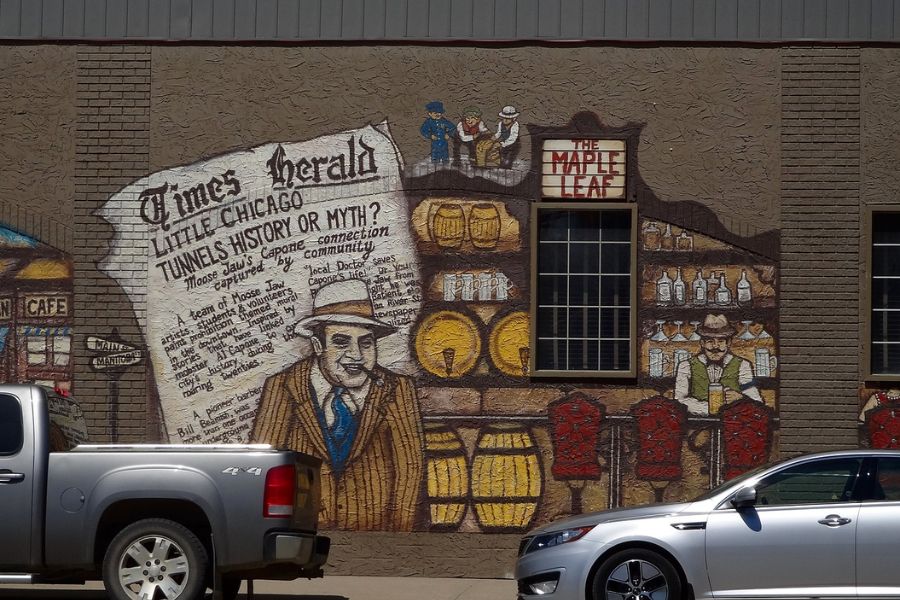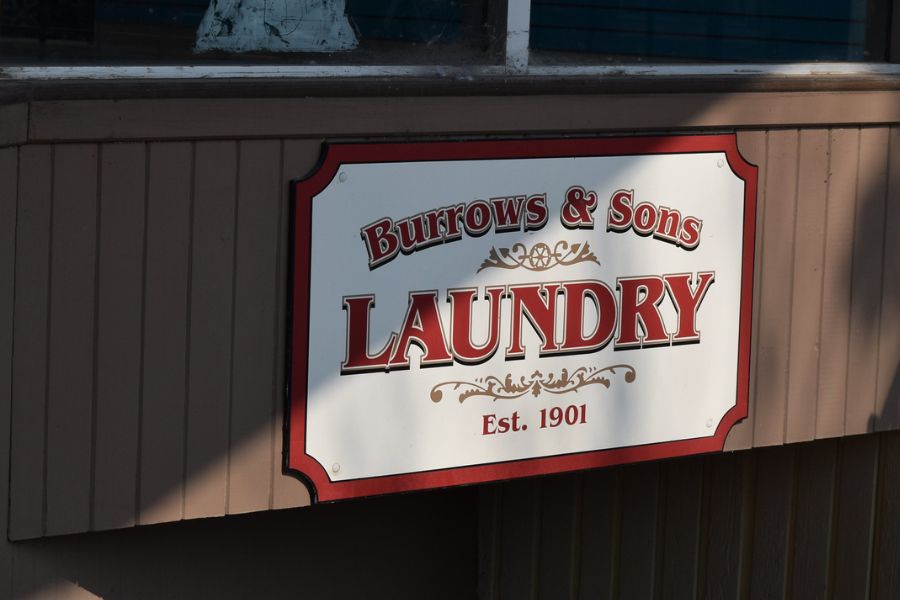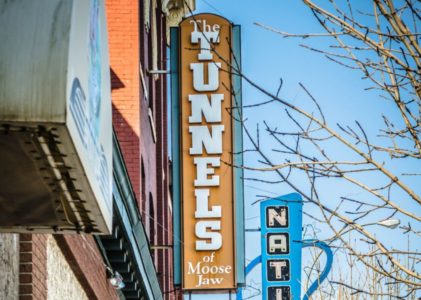You’d think of Moose Jaw, Saskatchewan, as a sleepy prairie town, but you’d be wrong. This small city has a big secret: Its network of underground tunnels.
Long forgotten and now rediscovered, the Chicago Connection has captivated the imagination of local and international visitors’ imaginations.
Some say the tunnels have been around since the 1800s, once used by bootleggers and smugglers. Others believe they were once part of a massive munitions stockpile for World War I.
Whatever their true origins may be, it’s clear that there’s something special about this hidden gem in Moose Jaw. And we would love nothing more than to reveal what lies within the underground tunnels of Moose Jaw!
Ensure that you’re well-prepared by buying the right Canadian outdoor gear for your next expedition into the great underground tunnels of Moose Jaw. Whether you buy your hiking gear online or in-store, it needs to be the best to match the hike.
So now join us as we dive deep into the fascinating Canadian history and mysterious lore behind this fantastic feat of engineering!
The Early Beginnings: How the Tunnels Came to Be
The famous hidden tunnels of Moose Jaw have a fascinating history. At the turn of the 20th century, the small prairie town of Moose Jaw became home to over 7,000 residents. But they needed to find a way to move goods and people throughout the city without disrupting its surface streets.
The answer? Underground tunnels!
The Canadian Pacific Railway built this intricate system beneath the city’s bustling streets, allowing secret goods, people, and illicit activities to flow. The entrance and exit sites were hidden away. You would never guess that below the otherwise average-looking buildings were hidden gateways underground.
Today, these tunnels have been transformed into one of Moose Jaw’s most popular tourist attractions. Visitors can take guided tours through the historical passageways and learn about their past with museum-quality displays along their walk.
It’s a fantastic experience for anyone who wants to relieve the bootlegging days of AI Capone or feels like going on an adventure underground!

The Prohibition Era: Smuggling Booze Underground
In the 1920s, Moose Jaw earned a notorious reputation as a hub of underground crime. During this time, the city was home to large-scale bootlegging and smuggling operations.
Through a series of hidden tunnels and passages, smuggled goods were trafficked from one end of Moose Jaw to another without detection. This illicit underground network ensured citizens could enjoy an illicit tipple or two, even during the turbulent days of Prohibition.
To this day, these underground tunnels remain shrouded in mystery and are part of what makes Moose Jaw so fascinating. So many people have theorized about the origin of these tunnels—some say they were dug by Chinese immigrants working on the railroad. Others suggest Al Capone himself used them!
Regardless of who built them or why, these tunnels are a unique feature that has helped shape Moose Jaw’s rich history. While they’re no longer used to smuggle goods, they’re now open to the public and offer a unique glimpse into the city’s Prohibition-era past.
Tunnels Of Moose Jaw The Iconic Tourist Attraction
Another fantastic thing about the tunnels of Moose Jaw is that they are now open to visitors! Most of the tunnels have been refurbished and now boast a variety of activities, including guided tours and interactive exhibits.
Visitors can explore the underground tunnel system with new LED lanterns installed to illuminate the area. Some highlights of the tunnels include:
- A secret speakeasy where you can learn about Moose Jaw’s history as a significant hub for bootleggers during Prohibition.
- An elaborate system of passages known as “The Escapes” was built for Chinese immigrants to use to avoid detection by law enforcement.
- An interactive exhibit featuring life-size models depicting life in Moose Jaw during its heyday as a bustling railway town (complete with sound effects and dim lighting).
- Passage to Fortune tour, where you will experience the plights of the early Chinese immigrants firsthand!
- Gift shop filled with books and souvenirs related to the tunnels and Moose Jaw’s early days, when it was an integral part of Canada’s transportation network.
The tunnel tours provide a fantastic opportunity to explore some of Moose Jaw’s most historic sites. Visitors will gain valuable insight into what life was like during this period.
And since Moose Jaw is located in one of Canada’s most geographically diverse provinces, there are plenty of exciting things to do nearby too!
What You’ll See on The Moose Jaw Tours Ahead

On a tour of Chicago Connection, you’ll get to explore the amazing underground tunnels of Moose Jaw.
Walking through the old, winding tunnels, you’ll see artifacts from the city’s past—from the late 1800s when it was a notorious criminal and smuggling hotspot.
So, when you get some moose jaw admission tickets, be prepared for the following:
Illicit Activities
The underground tunnels were once used for all sorts of illicit activities by criminals and gangsters. You can still see the evidence of this activity in collapsed mine shafts, old distilleries, secret staircases, and hidden doorways. It’s genuinely a dive into history!
Old Relics
You will also learn about some of the fascinating stories that happened during this period — and get to see some of the old relics left behind.
There’s also a train car that was once used to smuggle Chinese immigrants over the US border—talk about an eye-opening experience!
On your tour through Chicago Connection, you’ll get an exciting glimpse into Moose Jaw’s past — one full of adventure and intrigue —plus some great photo opportunities too!
Other Attractions in Moose Jaw Sights Worth Visiting
If you’re interested in visiting the tremendous underground tunnels of Moose Jaw, you may be surprised to know there are other attractions worth seeing.
There are numerous Moose Jaw outdoor activities thanks to the unique shops, restaurants, and historical sites. Here’s a quick rundown of some highlights:
Temple Garden Mineral Spa
At Temple Garden Mineral Spa, you can enjoy relaxing mineral baths surrounded by the beautiful Saskatchewan prairies.
Whether you want to spend the day soaking in one of their outdoor pools or get a massage in their tranquil treatment rooms, this is an experience like no other.
Wakamow Valley
Walk through Wakamow Valley and explore Moose Jaw nature, its lush forests, rolling hills, and crystal-clear rivers. This hidden gem is home to plenty of wildlife and offers visitors hiking, biking, and bird-watching opportunities.
Moose Jaw Museums & Art Gallery
The Moose Jaw Museum & Art Gallery is an excellent place to learn about the history and culture of the city. This museum features interactive displays, educational programs, and art exhibitions. All the activities give guests an insight into the people and places that make up Moose Jaw’s vibrant community.
You may also consider doing Moose Jaw shopping at the art gallery or antique shops. And, of course, the Moose Jaw classes and workshops are also quite famous among tourists.
Moose Jaw Nightlife
When the sun sets, and the stars begin to twinkle, Moose Jaw transforms into a vibrant hub of entertainment and excitement. This charming Canadian city has diverse options for every taste and mood, from cozy pubs to lively clubs.
Start your evening by exploring the lively downtown Moose Jaw, where you’ll find many trendy bars and lounges. Then, step into a stylish cocktail spot and let the expert mixologists craft you a masterpiece. Sip on a perfectly shaken martini or savor a unique concoction that tantalizes your taste buds.
While you are at it, try out some Moose Jaw food! And enjoy the Moose Jaw transportation to any of these sights. Your experience would be incomplete without this.
Final Words
The history of Moose Jaw and its tunnels is an incredible reminder of how inventive and resourceful people can be when faced with a challenge.
The Chicago connection, passageways, and chambers are a testament to the creativity, resilience, and hard work of Moose Jaw locals who created them.
The Moose Jaw Tunnels are a must-see for any intrepid traveler looking for something extraordinary.
It’s a hidden gem with a fascinating story and vibrant local culture. Even the positive Moose Jaw reviews prove the tunnels should be on everyone’s bucket list.
So, don your detective hat, embrace your inner adventurer, and prepare to be captivated by the mysterious world beneath Moose Jaw.







